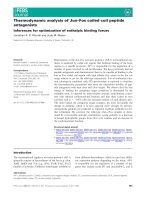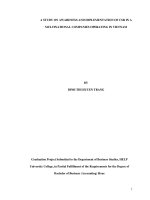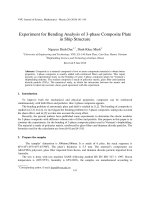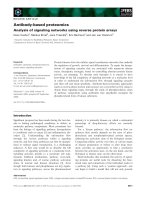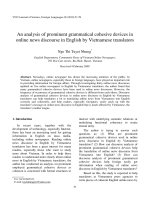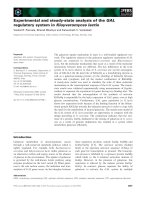Analysis of strategy of Toyota Motor Corporation operating in Vietnam pdf
Bạn đang xem bản rút gọn của tài liệu. Xem và tải ngay bản đầy đủ của tài liệu tại đây (574.45 KB, 29 trang )
STRATEGIC MANAGERMENT
Analysis of strategy of Toyota Motor Corporation
operating in Vietnam
Lecturer: PhD. Le Thai Phong
Class: QTRE312(2/1-1213).1_LT
Group’s member: Nguyen Thi Ha Phuong – ID: 1001030497
Ngo Thi Ngan Ha - ID: 1001030113
Tran Thi Quynh Trang - ID: 1001060189 3
Part 1: Background of Toyota Motor
Corporation’s road to Internationalization
1.A brief history of TMC
The Toyota Motor Corporation was founded in 1937 by
Kiichiro Toyoda. It originally started as a subsidiary of his
father’s company Toyoda Industries. The first vehicle, the
Toyota AA, was produced in 1936 whilst the company was
still associated with Toyoda. The brand as we know it became
established as an independent company in 1937 and changed
their name to Toyota. The name change was implemented to signify a separation of
work and home, to simplify the pronunciation and because it only took 8 brush
strokes (which is considered lucky) to write in Japanese. Toyota opened their first
factory in 1938 but it had to be cease production during World War II.
In 1950 the Toyota Motor Sales Company was established and
the company began production on the BJ Toyota Jeep, the BX
truck and the SG small truck. In 1956 the Toyopet chain was
established. The first vehicle to be sold under this name was
the Toyopet SA. The product line was discontinued in the
1960s due to negative connotations with the words toy and
pet. During the 1960s Toyota opened a new research and development facility as
well as establishing a prominent presence in Thailand. During this time Toyota also
celebrated the production of its 10 millionth model.
In 1982 the Toyota Motor Sales and Toyota Motor Company formed a merger to
become one company, the Toyota Motor Corporation. Following this the company
entered into a joint venture with General Motors called the New United Motor
Manufacturing Incorporated or NUMMI. Toyota operated a manufacturing plant in
Fremont, California as part of the deal. In 1989 Toyota launched their new luxury
4
product line Lexus. Toyota then followed this by focusing more on luxury vehicles
throughout the 1990s, adding vehicles such as the Camry sport, Scion, Prius and
Tundra to their product line.
Toyota are currently one of the largest corporations developing hybrid vehicles for
the commercial market. The company have also been involved in
many cutting edge technological developments involving
aerospace research and robotics. Toyota have also been
involved in many educational philanthropy projects over the
years including running the Toyota Technological Institute since 1981, which
offers scholarships to high school students. Currently the company are working on
the Prius plug-in hybrid which will be a fully electric vehicle that uses lithium-ion
batteries to extend its driving range.
A few statistics reveal the scale of Toyota’s operations, 75 years on from the AA:
- Worldwide production of Toyota vehicles (including sub-brands such as
Lexus and Daihatsu) was 6.9 million in 2011.
- It has 50 overseas manufacturing companies, in 27 countries and regions
worldwide.
- Toyota vehicles are sold in more than 160 countries and regions.
- In the 2012 financial year Toyota Motor Corporation’s net income was 283.5
billion yen – approximately £2.24 billion.
2. Toyota’s major sectors of operation
2.1 Electric technology
- Hybrid electric vehicle (HEV)
- Plug-in hybrids
- All-electric vehicles
- Hydrogen fuel-cell
5
2.2 Cars
As of 2009, Toyota officially lists approximately 70 different models sold under its
namesake brand, including sedans, coupes, vans, trucks, hybrids, and
crossovers. Many of these models are produced as passenger sedans, which range
from the subcompact Toyota Yaris, to compact Corolla, to mid-size Camry, and
full-size Avalon Vans include the Previa/Estima, Sienna, and others. Several small
cars, such as the xB and tC, are sold under the Scion brand
- SUVs and crossovers
- Pickup trucks
- Luxury-type vehicles
As of 2009, the company sold nine luxury-branded models under its Lexus
division, ranging from the LS sedan to RX crossover and LX SUV. Luxury-type
sedans produced under the Toyota brand included the Century, Toyota Crown,
and Toyota Crown Majesta. A limited-edition model produced for the Emperor of
Japan was the Century Royal.
3. Results of Toyota Motor Corporation’s business
activities.
6
4. An analysis of the choice of foreign markets
Any ambitious enterprise that is going to achieve and sustain profitability and profit
growth, no question, would have to expand business abroad, to gain extra market
and sales, and profit in result, by employing benefit of location and large scale
economies, experience and learning sharing effects. Therefore, US market with its
economic conditions is one of the most attractive environment for any firm to
expand foreign market.
Toyota Motor Corporation operates both automotive, under the brand
Toyota,Lexus,Hino and Daihatsu, and non-automotive and can be seen as one of
the best known automobile manufacturers. According to Japan Corporate News
network, in 2007, the firm sold over 8.5 million vehicles in more than 170
countries. Based on Toyota Motor Global News, the major Consolidated
Subsidiaries of Toyota Corporation across the world mainly locates in North
America, Latin America, Europe, and Asia/Oceania.
Toyota’s early way into market was quite struggling. In 1957, Toyota tried to enter
the US market, by establishing a subsidiary in California. Later, it proven to be a
nightmare; the Toyota cars performed poorly in road tests on US highway.
Obviously, Toyota people had not did enough homework on the basic local
conditions in US market, simplyhow Americans used cars. Due to lack of local
7
responsiveness, Toyota closed down its subsidiary and withdrew from market.
Back home, the company started to study the feedback from American consumer
surveys and US road tests, redesigned several of its models accordingly, and
reshaped its market reputation considerably in US market late 1960s, selling well
with welcomed product characteristics and consistently falling prosuction cost
retail prices. Thanks to the oil price following the Israeli/Arab conflict, US
consumer shifted to small fuel-efficient cars in droves. Toyota was among the main
beneficiaries. Though this desire for small fuel-efficient cars in US market
happened without Toyota’s prediction, it comformed to the traditional demand for
this nature due to the lack of natural resource at home, in Japan. However, market
changes. In early 1980s, imoport quotas imposed by United Stated over Toyota
stagnated export growth substantially. To cope with this problem, Toyota’s first
overseas operation, NUMMI, was born. Toyota established a 50/50 joint venture
named New United Motor Manufacturing, Inc with General Motor in USA in 1983.
Part 2: Business strategies of the TMC in
Vietnam
1. Toyota Motor Viet Nam (TMV)
Company name: Toyota Motor Company Vietnam
Date of establishment: September 5, 1995(officially went into operation 10/1996)
Total investment: 89.6 million dollar.
Main areas of activity:
- Installation, producing the kind of cars and auto parts.
- Provide warranty service and repair cars.
- Order processing and purchase from the supplier Vietnam, including
business processing, automotive spare parts for processing, packaging and
export.
8
- Perform the import of cars
- Imports of automotive parts and equipment, specialized machinery Toyota
standards.
- Consulting, training, support and implementation of internal business
development, and maintenance services for the products Toyota Toyota
Group companies, agents, candidate agents and the service station authorized
Toyota.
Products:
- Manufactured and assembled in VN: Camry, Corolla Altis, Innova, Vios and
Fortuner
- Sales of imported vehicles: Land Cruiser, Hilux, Yaris, Land Cruiser Prado,
Toyota Hiace and 86.
Capacity: 36,500 units/year/2 shifts
Partners:
Toyota Motor Company Vietnam (TMV) is a joint venture between 3 partners:
- Toyota Motor Corporation Japan (70%)
- Machine Dynamics Corporation and Vietnam agricultural machinery (20%)
- KUO Singapore Ltd. (10%)
Employees:
More than 1600 people (including seasonal workers)
Board of Directors:
- General Manager: Mr. Yoshihisa Maruta
- Vice General Manager: Ms. Dang Phan Thu Huong
9
2. External analysis
2.1. Macro environment analysis (PESTLE analysis)
According to Viet Nam Registry Department, the use of cars in Vietnam are
skyrocketing, at the end of August 2007, there were nearly 722,000 cars in
circulation, more than 66,000 units compared to end of 2006.
Assess trends related to globalization, Vietnam is being recognized as a member of
WTO which will stimulate growth in the domestic automobile market, thus
affecting the growth of this industry. Professional production and strengthening the
sales network are two main directions to the car manufacturing companies to
improve their competitiveness when Vietnam joins the WTO. According to the
general assessment of the experts, in 2008 car’s price will be lower than in 2007
due to financial markets’- real estate’s fluctuation, the plant and boost domestic
production capacity, competitive with current imported cars.The level of overall
growth is expected to remain at about 10-20% in 2008 - an attractive growth.
Socio- Economic Factors
However, the auto market after the Lunar New Year in 2008 is significantly lower
temperatures. Stock slump, real estate freezes, bank loans are harder before made
many people hesitate when buying cars. In many salons as well as imported cars
new cars, but vehicle for many buyers, car fairly quiet place.
The numbers as 2 months of 2008, Vietnam population nearly $ 400 million spent
entered car, motorcycle sales are a member of the Association of Vietnam
Automobile Manufacturers (VAMA) 1/2008 was 12084 vehicles , an increase of
156% compared to the same period in 2007.
Loại xe Bắc Trung Nam Tổng cộng
Xe du lịch 1,168 214 724 2,106
10
Xe đa dụng MPV 556 113 920 1,589
Xe 2 cầu việt dã SUV 276 53 280 609
Xe Minibus, Bus 447 216 442 1,105
Xe Tải, Pick-up & Van 2,618 1,353 2,704 6,675
Tổng cộng 5,065 1,949 5,070 12,084
Xắt xi xe buýt - - 96 96
Law Factors
From 2/4/2008, decision to raise taxes on the items brand new cars from 60% to
70% tax and goods vehicles for official implementation. This increase in import
tax was explained by the Ministry of Finance to reduce the burden of deficit
reduction and traffic jams in large cities.According to statistics of the Ministry of
Finance, in the first two months of the year, the country's trade deficit to more than
$4 billion, of which less than 12 turnovers car seat is importing 94 million dollars,
10 times higher than the same period years ago.
Low localization rate
As a rule, when granting investment would produce cars assembled in Vietnam, the
companies have committed to achieve a localization rate of 20-40% after a period
of 5-10 years. However, until this time, not companies that comply with that
commitment. Localization rate of automobile manufacturing joint venture in
Vietnam is very low. Accordingly, companies are only 5-10% local content, the
plan does not meet.There are two existing solutions to the automotive industry
development. The first is to increase the number of imported cars and domestic
production as planned in the transport sector. Second, the automotive industry on
11
the development of the strategy and "catch" the transport sector in order to reduce
development cost as well as other issues arise.
Taxes - heating problem
In just one year the tax rate for cars in Vietnam are changed three times, so
quickly,reflecting the non-transparent.Company representatives said GM Daewoo
reducing tariffs by 10% for finished vehicles will greatly impact the automobile
manufacturing companies in the country. If this car to import large share of the
market in Vietnam, domestic manufacturers will have to consider whether to
continue manufacturing or importing switch. This causes unnecessary disturbance.
2.2. Industry analysis
The characteristics of the automotive industry:
- Is the product expensive and long-term internationalization for many types of
customers
- The competition is fierce both in the domestic market in foreign markets
Therefore, the product should be attractive (operational features, quality, price)
that the appeal must be accepted by the customer (in the market).
- Requires a large capital investment and long-term development,
- Accurate risk management is essential requirement to ensure the profit
received by the huge amount of capital investment
- Many other industry participants
- Investment in large
- Tech-automotive industry as a strategic industry and key in many countries.
It requires constantly create greater added value and benefits received Toyota
and the automobile industry situation in Vietnam:
12
Toyota Vietnam is the market leader in sales of vehicles distribution to all relevant
objects.
2007 was a year of increased automobile consumption record. The growth of the
car market with no signs of stopping as sales Manufacturers Association assembled
Vietnam (VAMA) continues to set a new record for the month 11/2007, 18
members of VAMA sold 10,110 vehicles, an increase of 167% compared to the
same period in 2006 and was the highest sales month in the history of this
association. As for the product overall, Toyota led the market with 2,190 cars, was
far ahead of Changhai 1,390 units behind. Member Vinamotor third when sold
1,335 vehicles Vidamco also ranks fourth with 1,016 units. Ranked # 5 is still a
commercial vehicle company, Vinaxuki (940 vehicles).
About the competition
End of 2007, Vietnam's automobile market set a new record with more than
100,000 units have been sold. In the consumption of domestic enterprises 80 392
vehicles and 28,000 imported vehicles. Despite the record sales tank, but nowhere
compared to the still rising demand. In the last months of the year, both
domestically produced vehicles and imported vehicles, both cars and trucks are
selling cars and many are in a state of "fire" line. In 2008,the car will not be
missing this time many companies have started to boost production to meet the
needs of automotive customers. Toyota Vietnam will raise its capacity to 25,000
vehicles in 2008. Mr. Nguyen Van Quy - Deputy General Director of GM Daewoo
said line capacity of 10,000 vehicles is GM Daewoo / 1 year if production shifts /
13
day, while producing 2 shifts / day to 20,000 vehicles / year. The time is now
producing one new song, from Tet will increase 2 shifts / day. Ford Vietnam said it
will continue to increase capacity to meet the demand. In recent times the auto
companies have to hire many workers in order to increase production shift. Ford
Vietnam has recruited 300 employees. Honda, Toyota, GM Daewoo also recruit
new employees from 150-300.
Substitutes
These kinds of small cars like the Toyota Yaris, Kia Morning, Hyundai Getz,
Click consumers are particularly interested. In addition to stylish, compact, rich
colors, suitable for family activities, these vehicles are very fuel efficient,
especially when gas prices increasing current. Not just cars, but trucks selling all
kinds are selling. In 12/2007 of the first truck sold by VAMA members firms over
6,000 vehicles. Increased demand for trucks because many fear 2008 will increase
car prices. News from Xuan Kien private enterprise, in 1/2008, they sold to date
over 100 trucks with sales of over 20 billion coins. Mr Tran Ba Duong - General
Director of Truong Hai Automobile Joint Stock Company said 12/2007 this
company sold 1,500 trucks and cars sold thang1/2008 estimate of more than 1,500
vehicles as demand is rising.
Customers
The demand for cars rose sharply last year. Besides cars imported goods are in
short supply and rising prices. Many models have a very high demand as Camry,
Prado, Lexus (Toyota), Accord (Honda), BMW and Mercedes. Status with the
current car import of goods is very slow and always in a state are not enough of.
Many companies order large quantities, but the taxi driver to do so far not meet due
to imported cars stuck in the ports and not much capital to import more cars at the
same time. Not only the new small car kind of suck, but the newer vehicles
imported or domestically produced vehicles are priced between 25,000 more people
were interested in, such as the Hyundai Santa Fe, Honda Accord, 2008, Altis 2008
Almost there what kind of new car market in Western Europe, North America
most widely VN purchase. The cars are priced between $ 70,000 50,000 Current-
account for 30% of cars sold.Currently, if the customer wants to buy a car is to
deposit, advance reservations months to get the car. In fact, many companies
remain records of customer bookings, the new lunar vehicle can communicate.
14
Next time, if the company continues to launch more new vehicles to "stimulus" is
definitely in the VN car market will continue to bustling, vibrant.
3. Analysis of strategic issues of TMC in Vietnam
3.1. International strategies of TMC in Vietnam
Facing a firm with foreign market orientations are two apparently contradictory
goals, to reduce cost by product standardization and to cater to local demands by
product customizing, which unquestionably tends to raise cost. In order to deal with
these two opposing ends, several international strategies have been worked out,
namely global strategy, transnational strategy and multi-domestic strategy. Global
strategy focuses on increasing profitability and profit growth by reaping the cost
reductions that comes from economies of scale. Products are standardized across
national markets. Firms has top-down management and often lacks responsiveness
to local markets. The strategy applies best when there are strong pressures for cost
reductions and minimal demand for local adaption. A multi-domestic strategy
practioner increases profitability by customizing the firm’s goods and services so
they provide a good match to tastes and preferences in different markets. This
works most appropriately when customers show substantial difference in hobbies
and cost pressures are not too intense. A national strategy aims to simultaneously
achieve low costs through economies of scale and differentiate their products
offering across geographic markets for local differences. It fosters a multi-
directional flows of skills between subisdiaries in the firm’s global network of
operations.
15
Firms that aim to expand foreign market initially intends to gain benefits fo
economies of scale by boost product and service standardization. However, here
unavoidably arise problems of localization due to demand for firm responsiveness
to local conditions like customer taste and preference, local government regulation
and cultural traits, etc. In the international business matrix along two dimenstions
of pressure for cost reductions and pressure for local responsiveness, transnational
strategy has the highest degrees along both dimensions.
Amongst the typical international business strategies, Toyota, like many other
multinational enterprises, chooses transnational strategy. The need to compete with
international competitors like GM and Ford forced Toyota to look for greater cost
economies. However, variations in consumers’taste and governemnt regulations
acroos countries mean that Toyota also has to be responsive to local demands.
Therefore, Toyota confronts significant pressures for cost reductions and for local
adaptation. To cut costs by standardizing, Toyota has accelarated the process of
moving towards fewer vehicle platforms, with goal of building a wide range of
16
models on a limited range of platforms that share many common components parts.
To the nearly finished products, Toyot adds local product features, tailoring the
final output to local demand. Thus, toyota is able to realize many of the benefits of
global manufacturing while reacing to pressure for local responsiveness by by
customizing products.
Confronting the pressure to cut costs, Toyota redesigned their cars. There is a
significant consistency in the use of car components and accessories amongst
different products. It allows Toyota to invest in large-scale factories to produce
seperate components parts, thus reaping cost reduction by achieving economies of
scale. The components parts produced are not only for domestic use but also for
export For example, Toyota Motor Vietnam (TMV) expanded export field to
countries in the global network of Toyota, particularly with the operation of Toyota
Auto-Parts Export Center from July 2004.4
17
Export products of TMV include Antenna assy, ERG valves, Accelerator Pedal
Module which are exported to 13 areas of 10 countries under the Toyota global
IMV project including: Thailand, Indonesia, Philippines, Malaysia, India,
Argentina, South Africa, Venezuela, Pakistan, and Taiwan.
Lean production-a product of Toyota-is implemented in every subsidiary
worldwide. This production method supplies"what is needed, when it is needed,
and in the amount needed" , thereby eliminates the cost of holding buffer inventory,
waste, inconsistencies, and unreasonable requirements, resulting in improved
productivity.
Apart from a low cost structure, Toyota strives to build its competitive advantage
through product customization. They employ regional and local designers with aim
to build vehicles which well cater for local demands.
Tundra 07 – a pick-up truck type- is for North American market or the Scion xD
for the special taste of the youth here. European countries strongly advocate for
environmental policies so Toyota introduce hybrid cars like RAV4 and L600s with
CO2 exhaust fumes at only 99g/km.
18
3.2. Business strategies of TMC in Vietnam
3.2.1. Corporate-level strategy
“Corporate-level strategy specifies actions to be taken by the firm to gain a
ccompetitive advantage by selecting & managing a group of different businesses
competing in several industries &product markets.”
Horizontal integration is the process of acquiring or mergin with industry
competitors to achieve the competitive advantages that arise from a large and scope
of operations. This strategy may assist firms in cost reductions, product
differentiation or reduce external power. Conversely, merge and acquisition may
result in conflicts and problems.
A firm may participate in vertical integration, that is, to expand its operations either
backward or forward. By forward integration, the firm gains ownership or
increased control over its distributors or retailers, getting closer to its customers.
Backward integration grants the firm the control of its suppliers. Besides cost
reduction, vertical integration protects product quality through control of input
quality and distribution and service of outputs. From an internal viewpoint, this
strategy enhances production scheduling in response to rapid changes in market
demand. However, the embracement of suppliers or distributors into the firm may
eliminate their incentive to enhance performance. Managerial also work becomes
more complicated as the firm size increases.
Another strategy involves short-term and long-term contracts. Both companies
agree to make specialized investment and work jointly to lower costs or improve
product quality. This strategic alliance brings mutual benefit and lessens
bureaucratic work. However here exists the risk of breach of contract. Several
remedies being put forward includes hostage talking, credible commitment and
maintaining market discipline.
Outsourcing and diversification are also common corporate-level strategy. A
diversification practitioner will add new businesses, whether related or unrelated to
the company that are distinct from its established operations.
19
The automobile industry is featured with quality and updated technology. Toyota
apply the principle of “Quality First” so as to respond to the expectation of users.
Users expect manufactures to build in quality to the wide range of components and
for any condition of use. To meet this demand the company must advance the
quality in every activities especially component procurement.
Toyota purchases components directly from over two hundred suppliers all over the
world. However, since Japanese auto industry was founded before the component
industries, Toyota had to develop the component industry by itself. Twoo of the
largest component suppliers, Nippon Denso Co. Ltd., and Aisin Seiki Co. Ltd.,
were at first developed in Toyota and became independent later on.
Toyota participates in strategic alliance with hundreds of component suppliers in a
way called parrallel sourcing. Based on the principle of “long-term stable
transaction”, Toyota makes a unique “basic control of component transaction” with
a component supplier. On this contract Toyota confirms to promote long lasting
prosperity for both parties and an ideal quality assurance for customers. Hoping
that, perfect quality control is carried but by every component manufacturer,
Toyota includes in the contract the basic rules of quality control, the steps to be
followed when defective goods come out and etc.
In order to develop the component suppliers Toyota assists them in improving
management as well as quality control. Vvarious means are available for assisting
suppliers in improving systems of management such as:
- Toyota quality Control Reward
- Guidance of Toyota Production system (Kanban System)
- Mutual development by suppliers’ organization and etc.
After 14 years in operation and with great efforts, TMV has established stable
relationship with 11 suppliers in both the South and the North of Vietnam and
expects to have more in the coming time.
Input 1
Phase 1
Inventory 1 Input 2
Phase 2
Inventory 2
Input n
Phase n Final output
Inventory
Sales
20
3.2.2. Business-level strategy
Firms can be successful in the marketplace with outstanding features including
image, customization, technical superiority, price, quality, and reliability. Japanese
automakers Toyota has done very well by providing effective combinations of
differentiators. They sell both inexpensive cars and high-end cars with high-quality
features, and many consumers find the value that it provide hard to match.
Cost leadership
TMV utilse the corporation efficient manufacturing process and localization to
build a low cost structure.
- Just-in-time production (JIT Production)
The secret weapon is the production process made by Toyota. JIT means making
“only what is needed, when it is needed, and in the amount needed.” This
outweights conventional manufacturing method by eliminating waste,
inconsistencies, and unreasonable requirements, resulting in improved productivity.
Input 1
Phase 1
Input 2 Input n
Phase 2 Phase n
Final product
Sales
21
Figure 3: Conventional production
Figure 4: Toyota lean production system
As can be seen from the graph, JIT eliminates the need for each stage in the
production process to hold buffer stocks, which resulted in huge savings.
- Localization
Toyota believes that cost reduction can be achieved through localization, which
leads to further progress in regional and global exports. The corporation therefore
maximizes local R&D functions and capital expenditure to achive local
procurement rate of 100% at the earliest possible stage.
With the investment capital of over US$ 89 million, TMV has completed car
production process with four lines including Stamping, Welding, Painting and
Assembly. A frame shop has also been put into operation with the purpose to
enhance localization ratio and the cost competitiveness with auto welding and
painting lines.
22
TMV has made great efforts to call for the spare parts suppliers under Toyota
Group investing in Vietnam such as Denso, Toyota Boshoku Ha Noi, Toyota
Boshoku Hai Phong, Toyota Gosei Hai Phong to produce and export of auto parts
to the world. TMV unceasingly studies and looks for the domestic suppliers to
increase localization ratio.
Differentiaton strategy
Entering Vietnam market since the beginning, Toyota Motor Vietnam has grown
strongly in both scale and quality. With philosophy of "Customer First", Toyota
Vietnam has been consistent to provide our customers with quality products and
excellent services through dealer network in nationwide. Those efforts have been
rewarded with trust and satisfaction of customers for Toyota.
- Corporate strong brand
In Vietnam, TMV has been the leader in market share ( 30-40%) and top car sales
since its advent in 1996. It proves that TMV has a strong corporate brand.
Customers often associate this brand with durability, reliable operation, efficiency
and fashionable look.
Toyota cars are praised for both their external modern look and their interior, which
benefits from roomy seats, admirable outward visibility and well-placed controls.
On the road, they provide the comfort and the quiet and smooth ride that should
please a wide swath of midsize sedan shoppers. Power and fuel economy are
excellent with either engine as well.
23
- Innovation
An automobile expert has said that: “You can't wait five years to introduce new
technology to a vehicle, major changes to the vehicle will keep them fresh in the
eyes of the consumer.”
TMV continuously review, update the old and introduce new products to Vietnam
market. It now offers a wide range of product : compact car Yaris, sedan Vios,
Altis and Vios, SUVs like Innova, fortuner and even truck Hilux. Each type is
regularly enhanced to give the users the best comfort.
- Wide dealer network and Customer service/After-sale service
Toyota always regard its service supply chain as the key to sustained success. This
chain is accountable for the supply of spare parts and accessories, car maintenance
and repair, and also other value-added services to customers.
Based on the research of Vietnam condition, TMV designates the standard of
periodic maintenance for each Toyota model. In an authorized Toyota repair center,
genuine body parts should be fitted and cars should be examined carefully.
Toyota technicians receive extensive, specialized collision repair training, and have
access to the latest high technology repair equipment which enables them to restore
vehicles to their original beauty.
TMV saves time for customers by implementing Express Maintenance, Express
body and paint service and 4hours Scratch Repair service. The service is avaible at
many car dealers from North to South
TMV Manufacturing Operaon
Part receiving and storage
(warehouse)
Vehicle assembly line
Welding shop
Maintenance shop
Paint shop
Administrave o'ces , canteen
24
3.3. Organizational structure of TNC in Vietnam
25
3.4. Modes of market entry.
Joint ventures
Toyota enters Vietnam ‘s market through foreign direct investment by venturing
with local country such as: Vinh Phuc Toyota, Lang Ha Toyota …. It was founded
on 5.9.1995, put into operation on 10/1996, legal capital of 49,14 millions USD,
contribution rate between 2 parties is 70% - VEAM 20% - KUO 10%.
Since it was early established, Toyota has focus on developing all targets
Success in business, protect environment and community development. Among
those targets, Vietnam has gotten the significant targets.
Success in business
TMV always lead on Vietnam car market
- Protect environment: TMV is the first manufacturer of Vietnam perform and
receive certification ISO 14001.
- Community development: contribute to social on all field: Train and develop
human resource, economic – social, culture, sport…
Take modern cars into Vietnam
Camry with modern, luxury and powerful style; Corolla gain customer ‘s believe
and become one of the best-selling car all over the world
Export entry
In 2006, TMV is the only car corporation getting export reward of Ministry of
Commerce for corporation with high export

